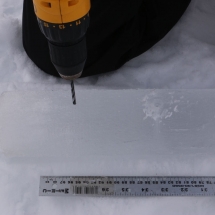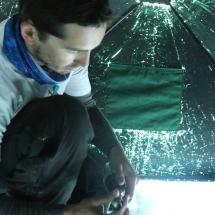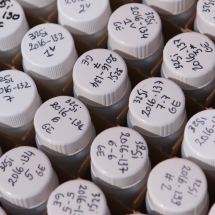Sunlight energy: both vital and corrosive for microscopic algae
Microscopic algae known as phytoplankton are photoautotrophic organisms. That is to say that like higher plants, they use minerals (C02, P, N …) and energy from the sun to grow and multiply. As the base of the marine food chain, they are also the base of organic matter production and the sequestration of atmospheric C02. Because of this, understanding the processes controlling their biomass and degradation is a major challenge for scientists.
The degradation of microscopic algae has long been regarded as essentially biological in nature (bacterial remineralisation). However, it appears that in some areas these processes are negligible compared to non-biological phenomena such as light degradation (photodegradation). This is what interests Rémi Amiraux and Lise Artigue. In fact they found that not only is photo-degradation is particularly intense in high latitudes, but it may also limit biological degradation. Their objective is twofold: to characterize the photo-degradation of algae based on perceived light intensities (in both ice and water), and to determine the extent of the impact of light degradation on bacterial degradation so that they can better understand how these processes work and will evolve in the future.
In effect, the Arctic is one of the zones most impacted by climate change. Increasing temperatures are inducing a reduction in the extent and thickness of the winter ice pack and are permitting more light to penetrate into the water column. This study aims to determine if an increase in light penetration induces an escalation or diminution of photodegradation processes and consequently, in bacterial degradation. Given that photodegradation is incomplete, and does not extend to the mineralization of organic matter, it can be assumed that an increase in photodegradation would, by short-circuiting bacterial mineralization, result in better export and sequestration of organic matter (C02 metabolized by algae) to the deep ocean.
When the microscopic algae are alive, as many of them at the start of the bloom, the energy captured by chlorophyll is almost entirely used in

photosynthetic reactions (see figure below at left) and is stored. This energy reserve allows the growth and multiplication of algae. A small portion of this energy (<1%) will to form excited oxygen molecules having the ability to degrade cellular and extracellular components. To counter this process, algae are equipped with photoprotective systems.
When the algae are dead (see figure below at right) as many of them at the end of phytoplankton bloom, energy captured by chlorophyll
is entirely directed towards the production of excited oxygen molecules and is therefore harmful. This oxygen quickly saturates the photoprotective systems inducing degradation of a large number of cellular and extracellular components that adjoin the phytoplankton, such as bacteria.











